What Are Webinar Conversion Rates & How to Optimize Them
Sarah Wisbey
Content Contributor, HeySummit
The global webinar market is worth over a billion dollars, and for good reason. Webinars allow you to show dozens, if not hundreds of leads in one go how your offer solves their problem.
Hosting a webinar is stressful enough as it is: finding the right audience, creating the content, setting up the right tech, and how do you even know if all that work is converting to sales? Are you wasting your time on sub-par webinars that don’t drive conversions?
Want to know precisely how to figure out your webinar conversion rates? In this article, we’ll cover how to calculate your webinar conversion rates, along with handy tips for optimization.
Let’s dive in.
What Is a Webinar Conversion Rate?
A webinar conversion rate refers to the number of attendees who take further action after virtual events. This action could be purchasing a product, signing up for future paid events, or joining your online community.
You decide your conversion goal for each webinar and whether you want to track only webinar sales conversion rates or track conversions at each stage of your funnel.
The Importance of Tracking Webinar Conversion Rates
You wouldn’t run a paid ad and not check your return on investment, so why run a webinar and not check the metrics?
Tracking your webinar conversion rate helps you evaluate your webinar’s success and make data-driven improvements.
For example, your goal might be to make sales from your webinar, but most of your attendees drop off mid-way through. When that happens, it suggests your webinar attendees found the content unengaging and lacked answers to their most pressing questions.
When you effectively track your webinar conversion rates, you can
Identify your best-performing webinar style and content.
Use the metrics as a benchmark to create realistic goals for future webinars.
Analyze which speakers your audience resonates with most.
Gain visibility on your audience’s most significant objections and common webinar FAQs.
Tweak your targeting and lead generation strategies (high attendees and low conversion may mean you aren’t targeting the right leads).
Stay within your budget (and avoid overspending on webinars that don’t convert).
How to Calculate Your Webinar Conversion Rate
You can use a simple formula to calculate your webinar conversion rate.
First, you decide what counts as a conversion (whether it’s a signup, a sale, or something else) and then divide the number of people who took that action by the number of attendees.
Multiply this number by 100 to get your conversion percentage.
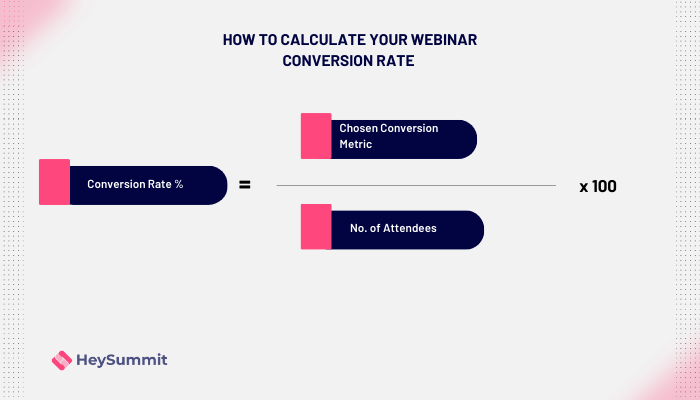
So, for example, if you had 250 people attend your webinar and 50 bought the ebook you were promoting, you would calculate your conversion rate like this:
50/250 x 100 = 20%
What Is the Average Webinar Conversion Rate?
Knowing your webinar conversion rate is valuable because you can use it to iterate and improve your process. But how are you stacking up against industry trends and average conversion?
According to research by On24, the average conversion rate from a live webinar is 53% across different industries. This makes sense because the registrants who attend the webinar (approximately 50%) are highly qualified leads with a strong intent to engage.
On24 reports that the average number of webinar attendees is 200, leaving ample opportunity to convert webinar leads into paying customers.
5 Types of Webinar Conversion Rates & How to Improve Them
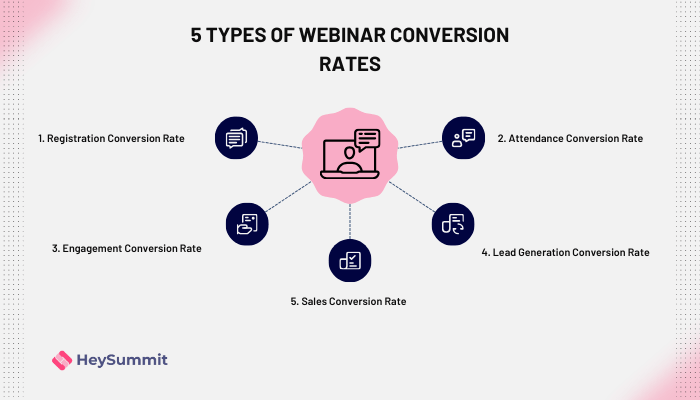
We covered the most straightforward webinar conversion rate, but there are different metrics to consider at each stage of your marketing cycle.
Focusing on different aspects of your webinar sales funnel will give you the complete picture of how cost-effective your webinar strategy is so you know where to improve.
Pro tip: Set a clear goal before analyzing different webinar conversion rates.
For example, “I want to use my webinar to sell my online course” or “I want my webinar attendees to book a sales demo.”
Let’s look at the different webinar statistics to pay attention to.
1. Webinar Registration Conversion Rate
This metric focuses on the number of sign-ups to your webinar compared to the number of people who land on your webinar promotion page.
Calculate the percentage by:
Number of webinar registrations / number of page visitors x 100
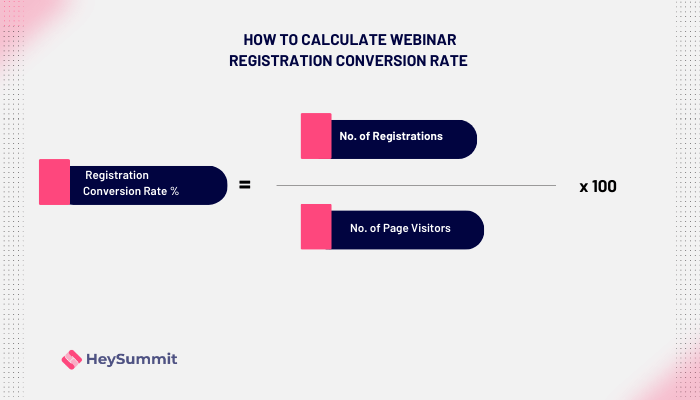
Why should you measure the registration conversion rate?
This metric helps you understand the quality of your webinar leads at the start of your customer lifecycle.
Weak leads with minimal interest in your product or service will be more challenging to convert further along your funnel. If you’re using webinars to generate business, you want high-quality leads.
You can also use this metric to assess your marketing and advertising budget. If you’re spending $1,000 on ads but only getting ten sign-ups, you will need to reassess your marketing efforts.
How to improve your webinar registration rate
If you get many visits to your webinar landing page but not many webinar sign-ups, it suggests your webinar page copy isn’t compelling enough to attract attendees.
When making tweaks to your marketing efforts and webinar promotion page copy, think about the following:
Are you clear about what happens when attendees sign up and what they will gain from the webinar?
How will the webinar solve a pressing problem?
Will attendees get exclusive access to an expert or product if they join?
Are you talking directly to your audience with concise and compelling copy? (Rambling explanations put people off).
Is the call to action clear?
Is the registration process easy, or does friction cause people to abandon sign-up?
High page views and low sign-up conversion may also mean your promotional material isn’t attracting suitable leads.
In that case, analyze how you’re attracting people to the page.
For example, people from your email list tend to be warmer leads than those from paid social media ads. They have already decided to sign up for your email list and are more likely to engage with your material.
Learn More: How to create a killer webinar funnel
2. Webinar Attendance Conversion Rate
Attendance conversion is the number of people who sign up for your webinar and show up.
You calculate the percentage by:
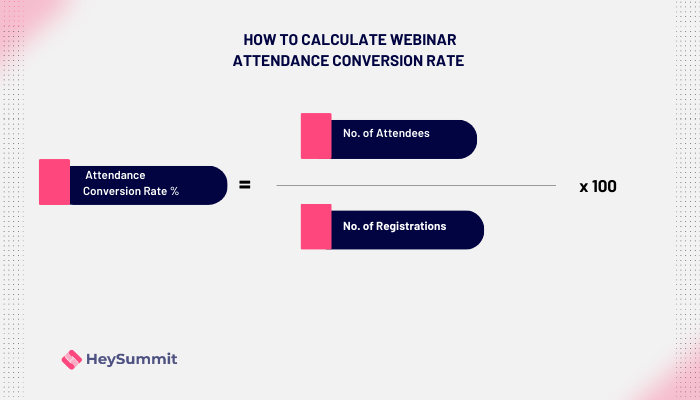
Why should you measure your attendance conversion rate?
This metric is vital for understanding the appeal of your webinar content and whether you got the messaging and target audience right.
The number of attendees directly impacts whether or not you achieve your goal, so don’t underestimate its importance.
How to improve your attendance conversion
If you have a low number of webinar participants, you may need to change your pre-webinar communications.
To improve webinar attendance rates, think about the following:
Did you send enough emails before the webinar to keep the prospect engaged?
Did your communication excite them and compel them to attend after registering?
Did you use social media to hype up your event and make it unmissable?
Is there an exclusive offer or learning attendees can get from the event?
Is your webinar at a time that many people can attend? If not, consider an evergreen or on-demand webinar.
Is there one clear goal for the webinar, or is your messaging confusing?
Is it easy to access the webinar via your chosen webinar platform, or do the attendees have to download a new program to attend? If this is the case, it could instantly hinder attendance rates.
3. Webinar Engagement Conversion Rate
It's a little more challenging to measure, but your engagement conversion helps you determine the value of your webinar content.
When you use a tool like HeySummit for your webinar, you take all the guesswork out of tracking engagement. Comprehensive analytics give a complete overview of how people engage with your video content.
Attendance duration can be part of your engagement rate (how many people stay for the entire webinar), along with the number of people who interact: ask questions, participate in polls, or engage in discussions.
You calculate the engagement rate by:
Number of participants who engage / number of attendees x 100
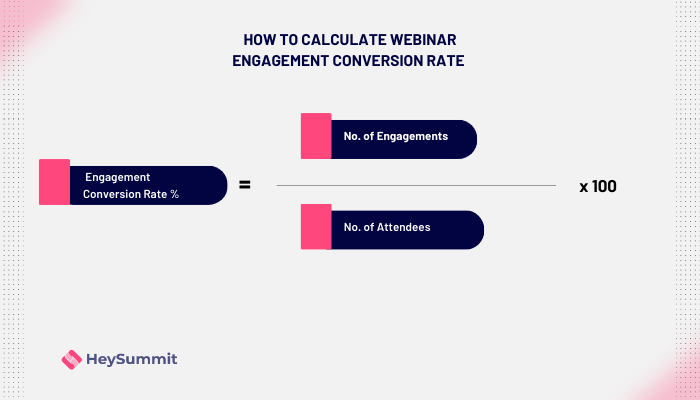
Why should you measure engagement conversion rate?
Understanding the engagement rate of your webinar gives you insight into how likely your attendees are to convert to paying customers. A lack of engagement generally means a lack of interest in your offer.
Data from On24 reports a 143% increase in chatbot engagement within webinars in the past year, suggesting that people attend live events because they have questions they want answered.
You can use engagement tracking to analyze the most frequently asked questions about your business. These insights ensure you always cover the most pressing topics in future webinars.
How to improve your engagement conversion
If you want more engagement with your webinars, you need to make the content engaging.
Reminder: One speaker giving a monotonous presentation about your product doesn’t make for engaging content!
Here are some ideas to improve your webinar engagement:
Make your webinars interactive by hosting a discussion or opening the floor to your audience.
Invite guest speakers with a big profile to give an interview on a compelling topic.
Leverage the use of happy clients to talk about their experiences with your product and how it’s made their lives easier. Check out this example from Meet Edgar and how asking a guest speaker to share her insights about using the tool got them 586 new email subscribers:
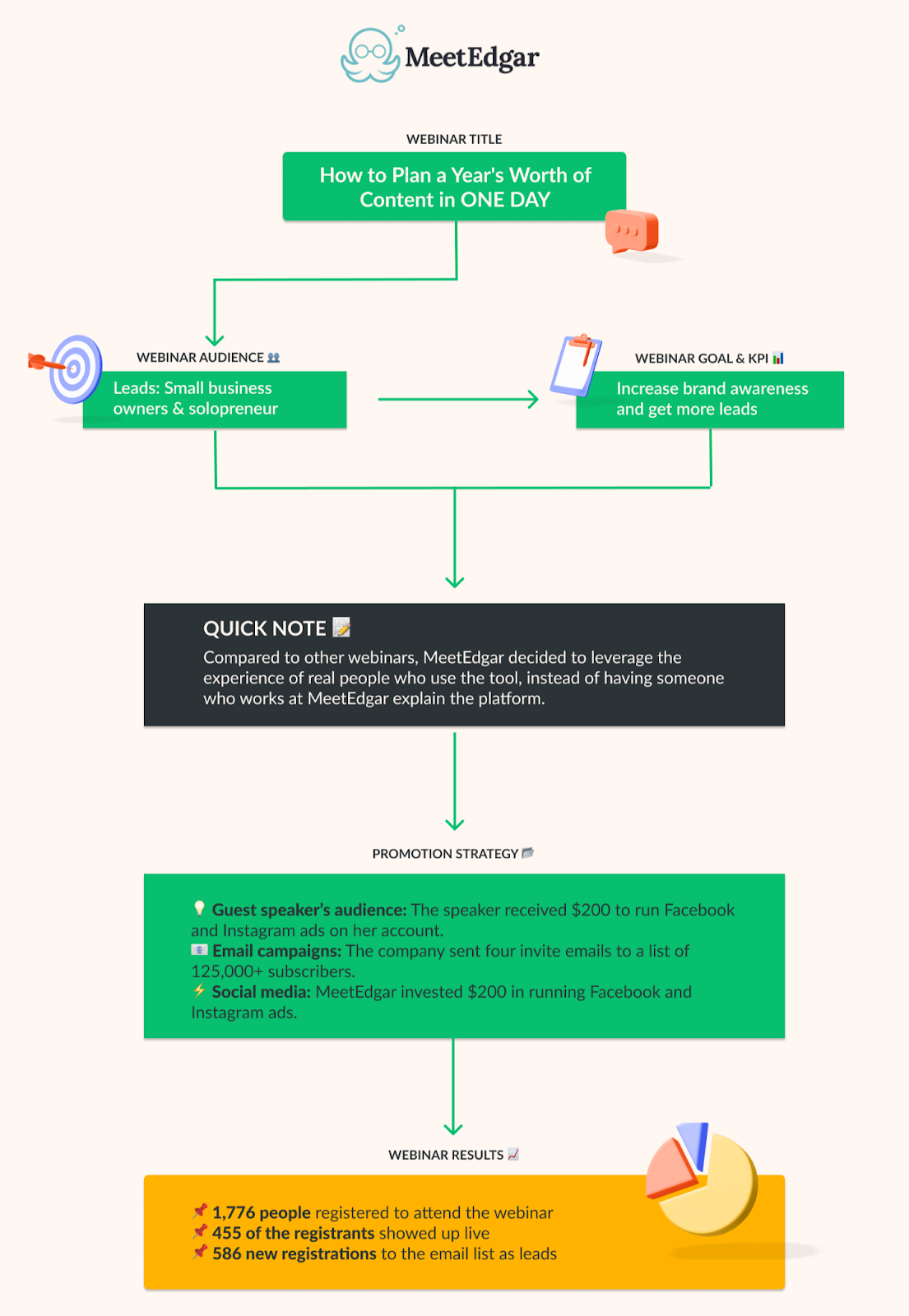
Source: Demio
Encourage participants to reflect on what they learn — this could be a small exercise or a worksheet you share during the webinar. The attendees will feel they get more out of the webinar if they actively use their new learnings rather than passively listening.
4. Webinar Lead Generation Conversion Rate
Lead generation means turning strangers into warm leads or potential customers, such as collecting sign-ups for your newsletter or getting people on a waiting list for a product launch.
Calculate the lead conversion rate by:
Number of leads on your list / number of attendees x 100
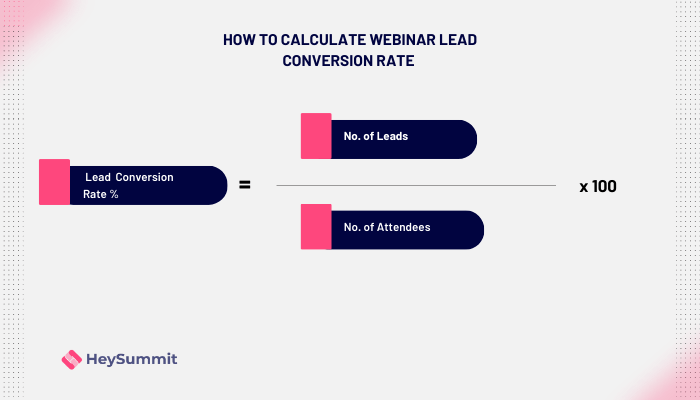
Why should you measure your lead generation conversion rate?
If generating leads is the primary goal of your webinar, you need to know how many people took the action you wanted them to take. This will help you establish whether or not your call to action is clear. It will also give you insight into the effectiveness of your host’s pitch.
How to improve your lead generation conversion
Setting one clear goal for each webinar will help you improve lead generation and make the call to action as easy as possible for audience members.
Here are some other considerations:
Are you clearly highlighting the benefits the lead will get from completing the CTA?
Does your webinar teach the audience something fascinating and new?
Does your webinar audience get the chance to voice objections or participate in a live Q+A?
Try A/B testing different calls to action to discover which messaging resonates best.
Collect participant feedback to find out why they didn’t take the action; this will help you iterate the process for next time.
5. Webinar Sales Conversion Rate
Want to figure out the direct return on investment from your webinar? Then, you’ll need to calculate how many sales your webinar generates.
How to calculate your sales conversion rate:
Number of sales / number of attendees x 100
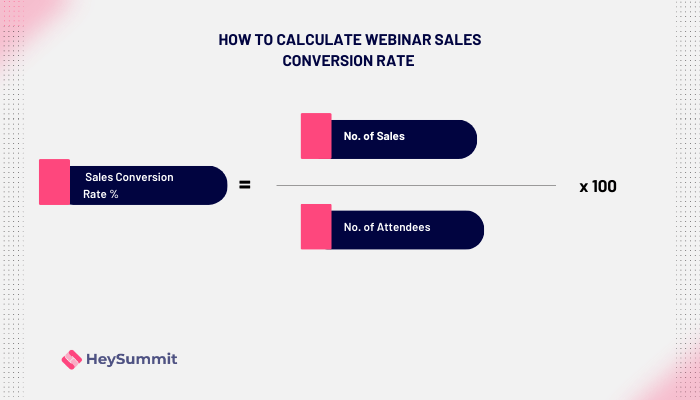
Why should you measure your webinar sales conversion rate?
If you’re hosting a webinar with the primary goal of selling, this is the most crucial webinar metric to focus on. With your sales conversion rate, you can directly measure the monetary success of your webinar and decide whether it’s worth investing in more webinars.
How to improve your webinar sales conversion
Want more sales directly from your webinar? Try to:
Use the webinar to address any objections from your leads.
Demonstrate the value of your product or service, create excitement, and show how it solves your client’s problem.
Follow up promptly so attendees don’t forget about you.
Provide exclusive, time-sensitive offers and content to webinar attendees.
Send an easily shareable replay of the webinar.
Key Takeaways For Creating a Successful Webinar
To improve your webinar conversion rates across the board:
Define a clear goal for each webinar.
Use your marketing material to attract a targeted, relevant, easily convertible audience.
Create inspiring, helpful content.
Make your webinars interactive with opportunities for Q&As.
Demonstrate value and show attendees how your business solves a problem for them.
Don’t forget to follow up.
Give exclusive offers for webinar attendees.
Want to take the hassle out of analyzing your webinar metrics?
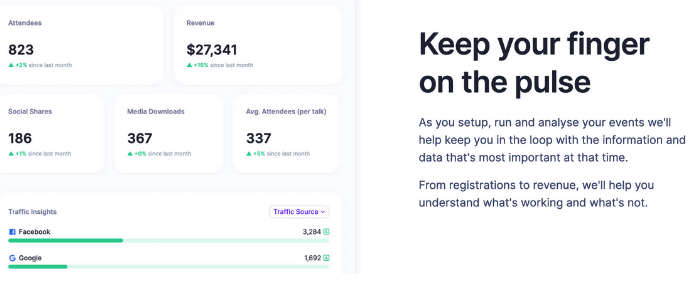
HeySummit, the Online Event Platform, has an easy-to-read dashboard with all your data in one place, so you can quickly analyze what’s working and what isn’t. Say bye to underperforming webinars and hello to events that get you conversions. Make your life simpler and sign up for your free HeySummit trial.
Table of Contents
What Is a Webinar Conversion Rate?The Importance of Tracking Webinar Conversion RatesHow to Calculate Your Webinar Conversion Rate What Is the Average Webinar Conversion Rate? 5 Types of Webinar Conversion Rates & How to Improve ThemKey Takeaways For Creating a Successful WebinarWant to take the hassle out of analyzing your webinar metrics? Try HeySummit free
HeySummit is the easiest way for creators and educators to grow their audience, authority and revenue with professional online events created in minutes, not weeks.
Share this article on:
Recent Posts
Loading feed...